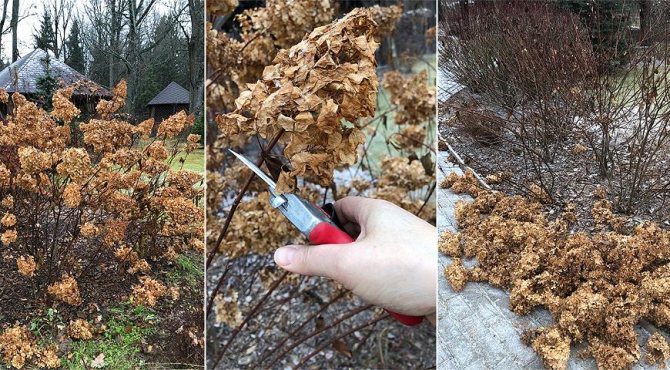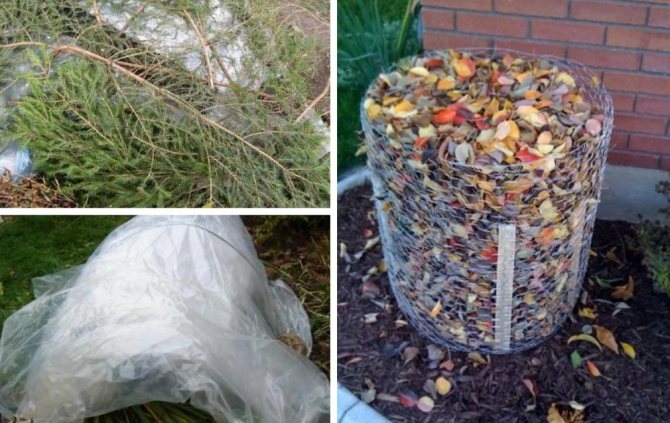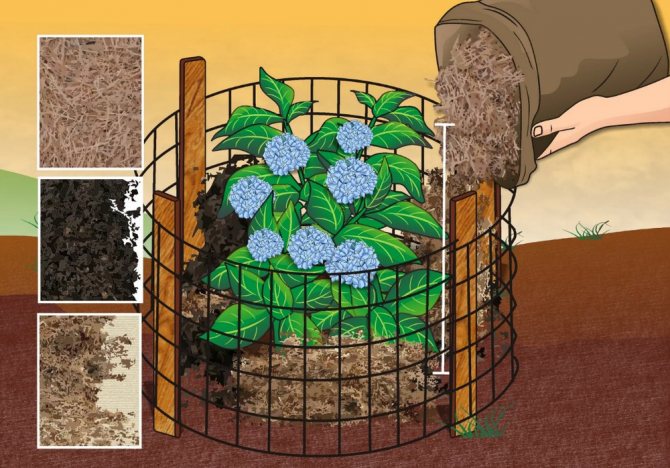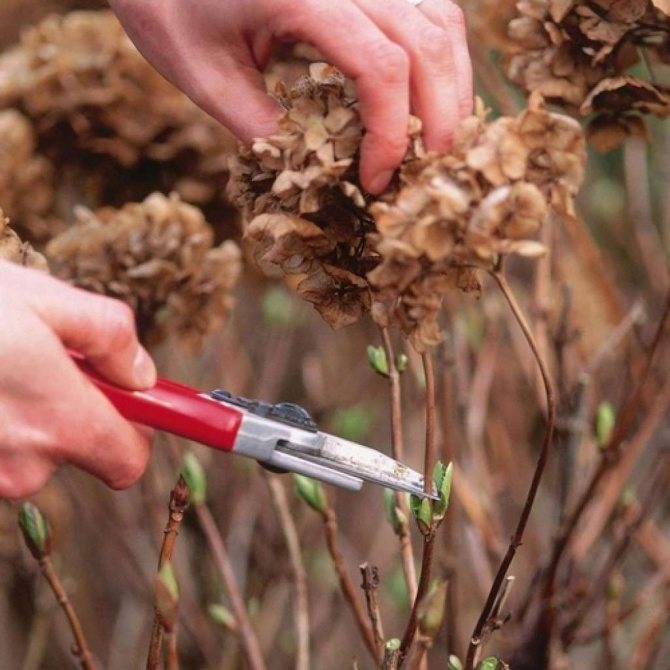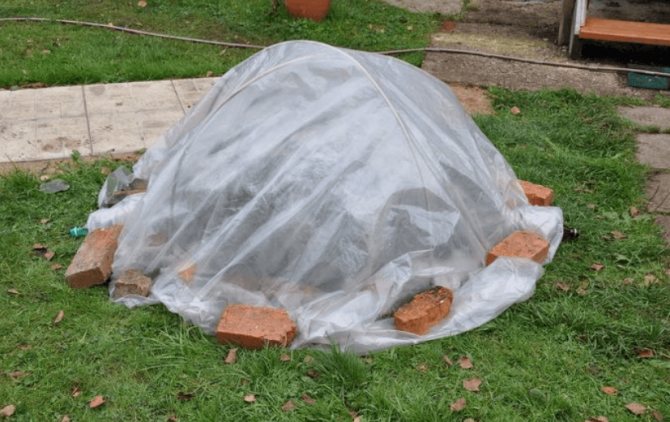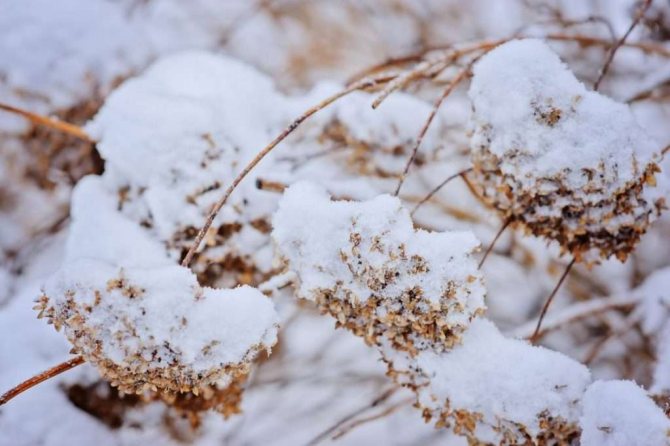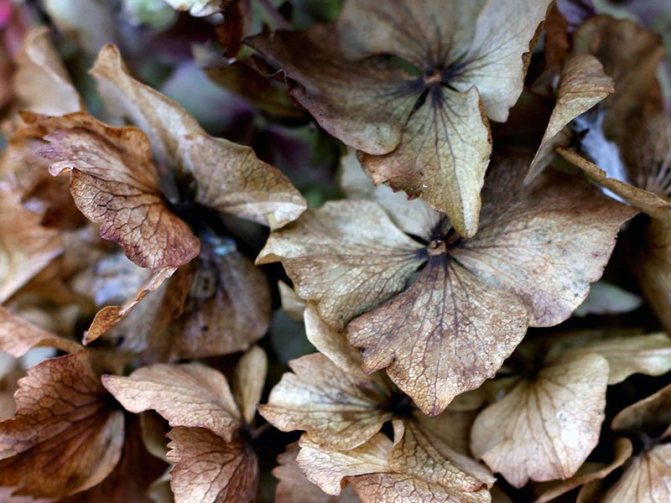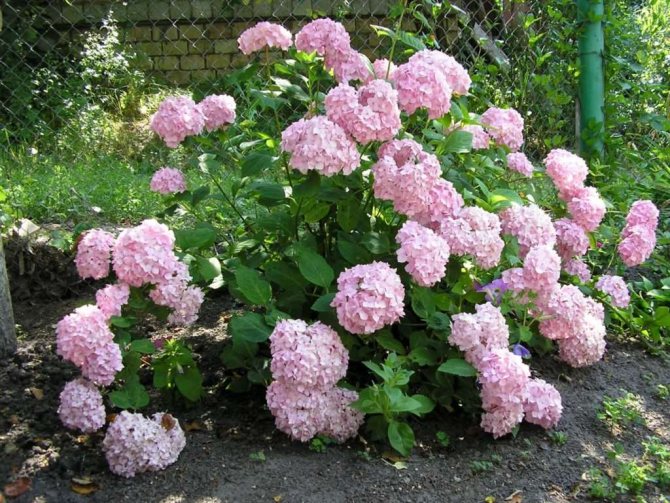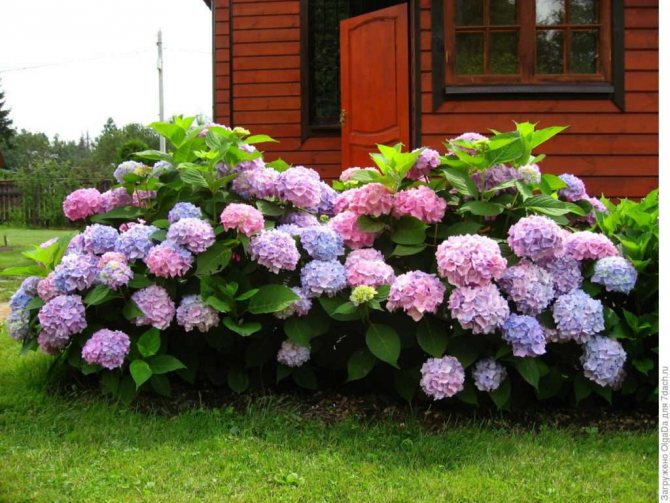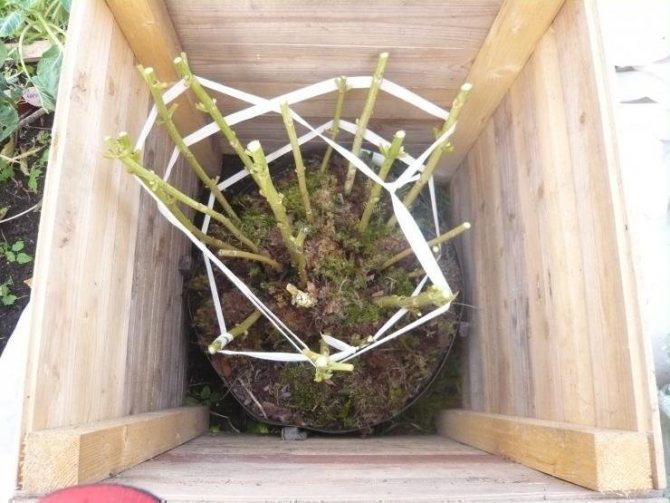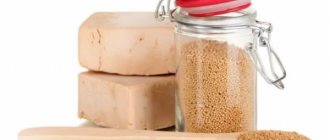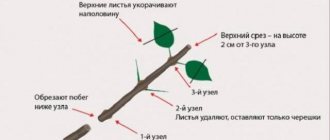In the middle lane, plants are mainly grown that are adapted to our climate and there is no extra hassle with them. But I really do not want to give up the cultivation of ornamental shrubs not of our latitudes, the care of which in our conditions requires additional efforts. Moreover, these plants are extraordinarily beautiful.
One of the most popular of these plants is hydrangea, which is very much loved by our growers. But it requires some care, and especially preparation for winter, since only the observance of certain conditions will allow the hydrangea to bloom profusely and delight the owners with beautiful flowers.
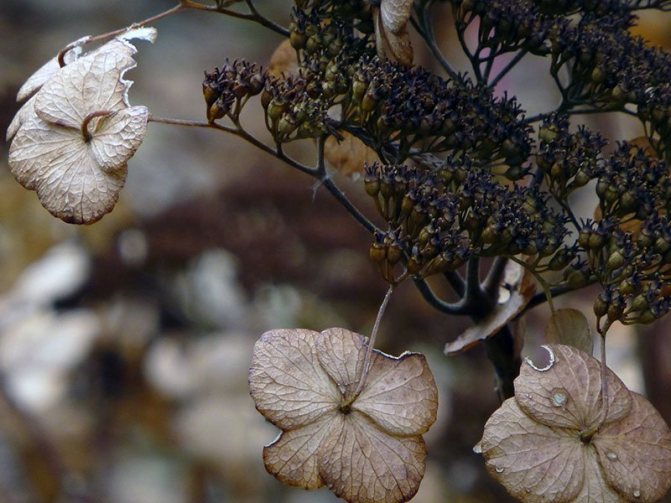
How to properly prepare a hydrangea for wintering
It should be noted that not all types of hydrangea do not tolerate well overwintering without shelter. Of the three most popular species - tree, paniculate and large-leaved - only the last one needs a mandatory shelter for the winter, since without shelter there is a high probability of freezing of the buds, which will prevent the plant from blooming normally next year. But it is important to remember that only adult bushes of paniculate and tree hydrangea can not be sheltered, since young bushes of these species also need protection in winter.
Hydrangea flower - description
Most of the species of hydrangea are shrubs with a height of 1 m to 3 m, there are among hydrangeas and trees, and lianas climbing tree trunks to a height of 30 m.Among the representatives of the genus there are evergreen species, and there are deciduous ones, but in our latitudes they are grown it is the latter, blooming from spring to late autumn. Two types of flowers are collected in globular inflorescences at the ends of the stems - sterile at the edges and fertile in the middle of the inflorescence. The flowers are most often white, but a species such as large-leaved hydrangea is represented by varieties with pink, blue, lilac and red flowers, and determines the color of the specimen by the acidity of the soil. For example, hydrangeas with blue flowers grow in acidic soil, lilac and pink flowers in alkaline soil, and pale beige flowers in neutral soil. The hydrangea fruit is a multi-parted box with seeds.


In addition to large-leaved, tree hydrangea grows well in our climate, known for its winter hardiness and ability to recover well after severe frosts. Panicle hydrangea, known for its durability, also winters well - it can grow in one place for up to 60 years.
- Lilies - care in the garden
In addition to these three most popular species, such species as serrata hydrangea, serrata hydrangea, climbing hydrangea, radiant hydrangea, Sargent hydrangea, petiolate hydrangea, oak-leaved hydrangea and others are known in floriculture.
Diseases
For the leaves and stems of hydrangea, a great danger is the defeat of downy mildew. The symptoms of this disease are oily yellow spots. Over time, they grow in size and darken. Young stems and the lower part of the leaves are covered with a yellowish bloom. The disease develops in high humidity during the hot season. To combat this disease, the leaves and stems are washed with a soapy solution containing copper, which is absolutely harmless to the plant.
Large-leaved hydrangea is affected by a disease such as chlorosis.Its sign is a change in the color of the leaves to a lighter one. The development of this disease is facilitated by an excess of humus in the soil. To combat this disease, you need to water the plant with iron sulfate and potassium nitrate.
Pruning hydrangea after flowering
Hydrangea care involves pruning, among other things. Some amateur flower growers argue that hydrangea is like lilac - the more you cut, the more luxuriant it blooms next year. This is not entirely true, since this statement is true for paniculate and tree hydrangea, and colored (large-leaved) hydrangea cannot be cut off. Large-leaved hydrangea blooms on the shoots of last year, so the young branches that have grown this summer should overwinter, and only next year they can bloom.
As for the species with white flowers, namely panicle and tree hydrangeas, they bloom on annual stems, so after pruning, as stated, they will have many young shoots that will give more flowers. It is recommended to prune hydrangeas in spring, but this should be done carefully, because the sap ferments in the plants, and they “cry” when pruning. Many growers believe that it is better to prune the hydrangea in the fall.
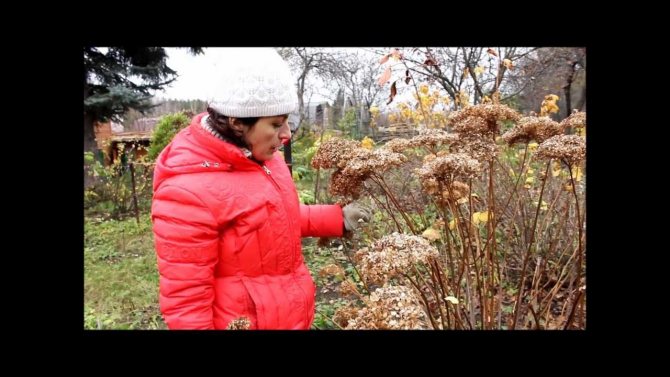

Based on these differences between species, hydrangeas were divided into two groups for pruning quality. The first group includes species blooming on last year's shoots, such as the already mentioned large-leaved hydrangea, as well as serrata hydrangea, prickly, Sargent, oak-leaved and liana petiolate. Pruning these hydrangeas can only be cosmetic, removing last year's inflorescences up to the first pair of strong buds and weak, old shoots completely.
The second group includes species in which buds are formed on the shoots of the current year: panicle hydrangea and tree hydrangea. The main pruning of these types of hydrangeas is usually done in the spring, before the start of the growing season. The tree hydrangea is subjected to the procedure only if it is already four years old, otherwise it may die, flowing out of juice. However, if pruning is done in the fall, this nuisance will not happen. An adult, and even more so an old plant that needs to be rejuvenated, is cut "on a stump", that is, only 10 cm is left from each shoot.
If the bush is too large and old, you do not need to prune it in one go, otherwise the short shoots will not be able to feed the large root mass. Rejuvenate the bush in parts over three years.
- Gerbera: home care
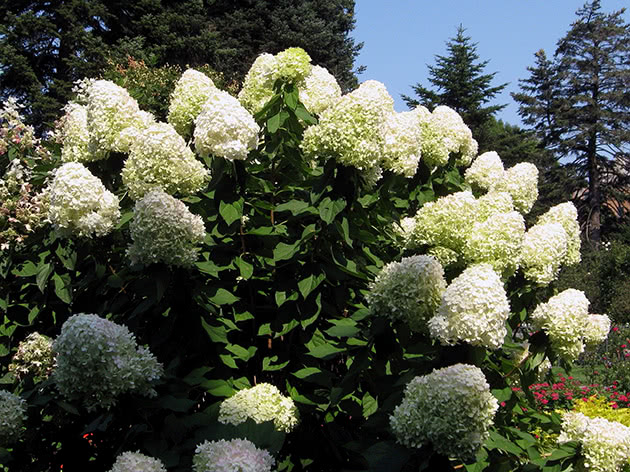

The panicle hydrangea is pruned moderately, like a tree, without touching the skeletal branches: from several shoots that grow from one point, only those that grow outward are left.
Pruning hydrangeas in the fall is completely safe and will give your plant a luxurious bloom next year. In the species of hydrangea of the second group, the inflorescences are cut off so that the fragile branches of plants do not break under the weight of the snow, which adheres to them in winter - this is if you do not intend to cover the hydrangea for the winter. In addition, old thick stems are removed from tree hydrangea, and weak thin shoots from panicle hydrangea, and annual growth is shortened by 2-5 buds.


Common mistakes gardeners make
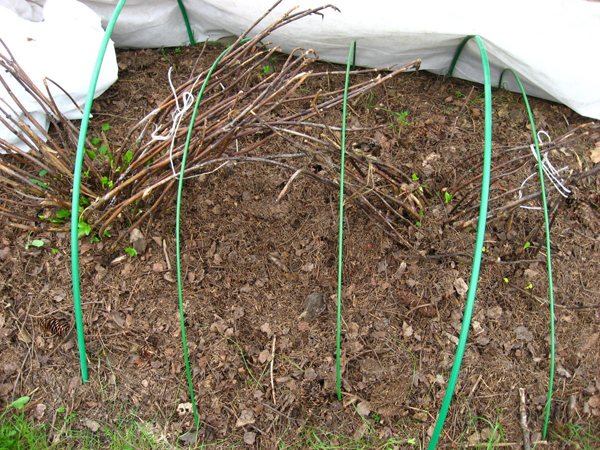

Newbie gardeners most often make mistakes not in organizing a shelter, but in removing it. As a result, winter protection in the spring turns into a source of various problems. Below are two of the most common mistakes when opening hydrangeas.
- Late withdrawal. You need to remove the winter protection with the arrival of heat. In areas with cold springs, it is left until the temperature rises above 00C. Unraveling too late threatens the occurrence of fungal diseases.
- Abrupt removal of cover.If all layers of protection are removed in one go, the bright spring sun will burn the wood, which will weaken the plant and inhibit its growth. To prevent this from happening, first remove the top material. In case of frost, it is installed back. The rest of the layers are removed gradually, already with the revitalization of the hydrangea buds. After removing the earth during hilling, the bushes are immediately untied.
The above instructions will help you avoid mistakes when organizing winter protection for your hydrangea.


Good preparation for winter is very important when growing hydrangeas on the site. In order to admire its flowering annually, in the fall, you should devote a sufficient amount of time to grooming and wrapping, if necessary.
Preparing hydrangeas for winter
Caring for hydrangea paniculata in autumn (and for other species too), on the eve of the onset of cold weather, involves the shelter of hydrangeas for the winter. Unfortunately, not a single type of hydrangea can winter in our area without insulation, so the preparation of garden hydrangeas for winter must be thorough. The most winter-hardy is the tree hydrangea, but it also needs shelter for the winter, otherwise the ends of young shoots may freeze.
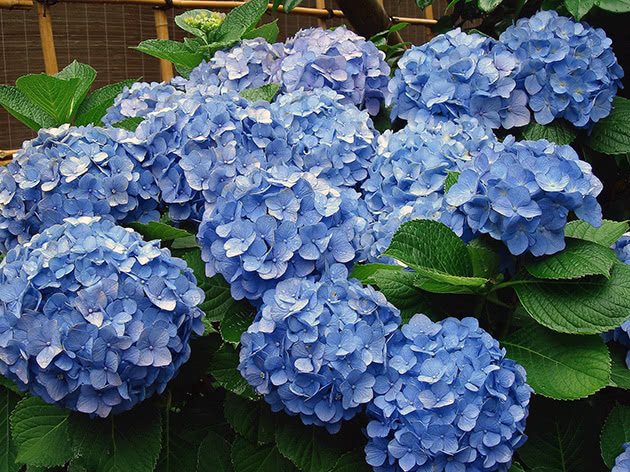

From mid-September, start preparing: remove all the leaves, except the very top ones, in order to speed up the process of lignification of the shoots, and feed the plants with phosphorus-potassium fertilizers (hydrangea is not fertilized with nitrogen in autumn). Now you can cover the hydrangea.
Spring work
With the arrival of spring in the Urals, it is necessary to remove the shelter from the bushes in early - mid-April, gradually removing layer by layer. Otherwise, the overwintered hydrangea will inevitably die with return spring frosts. First, remove the lutrasil, after 7-10 days it will be possible to free the shrub from the foliage. And only then remove the rest of the covering material.
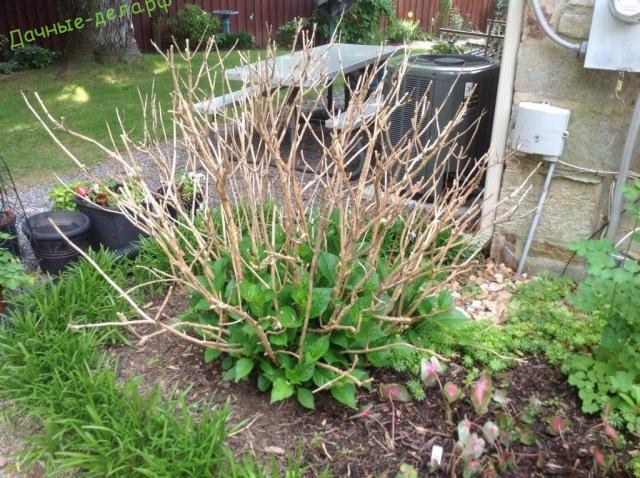

Plant care
Treelike and panicle hydrangeas are not too capricious... In order for the plant to grow stronger and delight with abundant flowering, you will need to follow simple rules:
- sufficient watering;
- root mulching;
- correct pruning;
- seasonal feeding.
The plant loves water very much, knows how to accumulate it... The very name of the shrub is translated as "A vessel with water". In summer, shrubs need 2-3 buckets per 1 bush, 3 times a week. In autumn - 2 times a week.
For 1 bucket of water, you can add any of the proposed acids, the main thing is not to overdo it:
- 2 g citric acid;
- 5 g vinegar 9%.
Useful tips for warming hydrangeas
Before winterizing hydrangeas for wintering, it is important to create suitable conditions in the flower garden:
- According to experienced florists, hydrangea flower culture grows well in shaded areas and on slightly acidic soils. Before wintering, the top layer of soil of the trunk circle is replaced with a mixture of top peat with humus from the foliage. It is even better to use fallen spruce needles for insulation.
- The introduction of potash and phosphorus fertilizers favors successful wintering. Such feeding contributes to the accumulation of nutrients that will help to survive the winter rest.
- Timely and correct pruning of faded buds.
Young specimens of hydrangeas, regardless of the variety, necessarily need additional insulation.
The choice of hydrangea insulation depends on the climatic conditions and the type of flower culture. If this choice is correct, then the flower grower will be rewarded for his work with the flowering of this truly magical flower.
When to shelter


Hydrangea is not a grape for you, its delicate shoots are afraid of even the smallest frost. Even at minus 1 °, the leaves turn black and die, while lower values kill flower buds. Therefore, do not wait for the first frosts, but try to be in time before them.
Get to work as soon as the night temperature has dropped to 2 °, and the daytime - to 6 °.For the Moscow region, this is approximately the first decade of October.
Experienced gardening tips
Irina Vladimirovna, 55 years old, Moscow.
I have been growing a tree hydrangea in my dacha for 10 years, and I love this plant very much. I cover with spruce branches and plastic wrap for the winter. My hydrangea blooms all summer long, winters well. She planted Christmas trees next to her, noticed that the flower bushes did not get sick, and there were no pests on them.
Sergey Mikhailovich, 62 years old, Zvenigorod.
My wife planted panicle hydrangea. And I myself am preparing for the winter. For 3 bushes I made domes from three layers of burlap. The bags were specially selected for old, still Soviet. They are dense, unlike what they are selling now. I cover the roots with moss and spruce branches, put on a dome, tie it with a rope. I cover it with a film on top. But with the onset of spring heat, I remove the film. And I remove the dome gradually: first for a day, and only after a week I completely remove it. The plant winters well and blooms every year.
Useful video
Watch a video on how to send a hydrangea for the winter:
If you find an error, please select a piece of text and press Ctrl + Enter.
Different types and varieties of hydrangea tolerate winter cold in different ways. In addition, they can grow in different climatic zones, so there are nuances in caring for them in the fall in preparation for the upcoming cold weather.
Below you will find information about autumn care and preparing the plant for winter, about pruning hydrangeas in the fall and sheltering it for the winter, which will be useful for both beginners and already experienced gardeners who have recently planted this perennial in their summer cottage.


Protective materials
When preparing plants for wintering, you need to take a responsible approach to the choice of protective materials. A prerequisite is that the shelter must allow air to pass through. You can cover the plant with roofing material, spruce branches, leaves, sawdust. It is worth using plastic wrap correctly. In case of improper use, the shrub underneath can be affected by fungus and rot.
Did you know? Hydrangea was introduced to Europe in 1820 from Japan, after which, in 1900, they began to select it and create new species.
Spruce branches
To cover the shrub with spruce branches, you need to spud the bushes well. Spruce branches are laid on the prepared trunk circle, after which the branches of the plant are bent to the ground. The last layer consists of a waterproof non-woven material. It must be securely fixed above the surface of the structure.


Leaves
The most popular use of dry leaves is to shelter hydrangea bushes. It is important not to use fallen leaves of fruit trees. It is best to cover the shrub with maple or chestnut leaves. Usually, this kind of shelter is clearly not enough to keep the plant from cold. From above, the protective layer must be carefully covered with burlap.
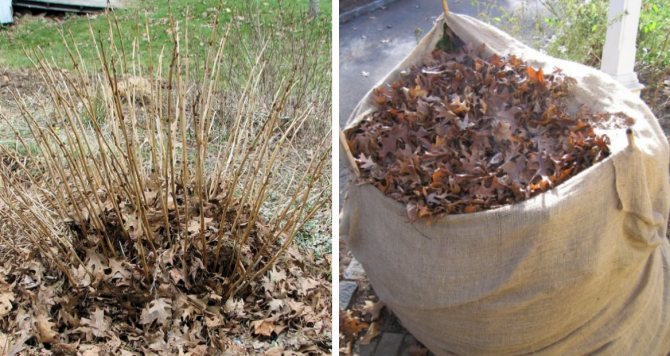

Sackcloth
It is good to use burlap as a winter shelter. To secure the hydrangea from the cold for sure, the material is bent into 2-3 layers. On top of the burlap, you can prepare a cover made of polyethylene film with holes.
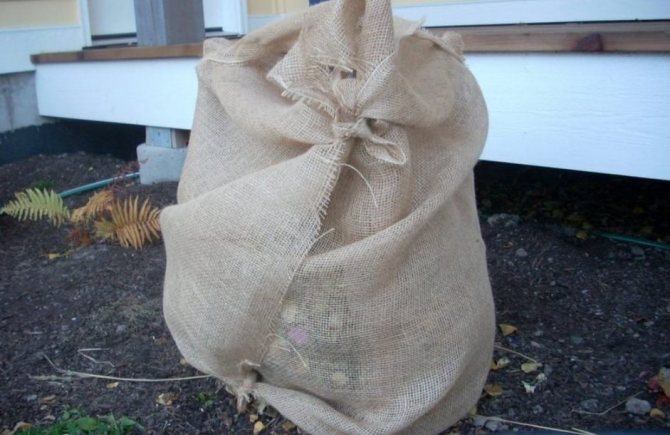

Polyethylene film
Shelter polyethylene film is used to protect shrubs from excess moisture. Hydrangea is not afraid of excess moisture, like, for example, roses, therefore it does not require special protection from water.
Important! In the spring, the film must be removed so that the plant does not get hot. If this is not done in time, the hydrangea can become infected with fungus or dry out.
Before you cover the plant with a film, you need to build several layers of non-woven material over it. At the same time, it is important to leave holes so that the shoots have access to air.


Features of the Siberian climate
It is not for nothing that Siberia is considered a zone of risky farming. The harsh climate significantly limits the cultivation of many agricultural crops, which are far from always successfully surviving winters with bitter frosts, when the thermometer stays below -40 ° for weeks.C... Fast off-season periods (spring and autumn), as well as short and not too hot summers leave an imprint on the rules of agricultural technology when cultivating thermophilic plants. However, thanks to the efforts of breeders, today this becomes possible. Sissy hydrangea can be seen more and more often in Siberian gardens.
What varieties do not require shelter
The most demanding care is the large-leaved hydrangea. It is not resistant to cold, so care must be taken to cover the plants. In addition to an artificial protective shelter, snowdrifts protect well from cold weather. Treelike are resistant to frost and well tolerate temperatures down to -30 ° C.
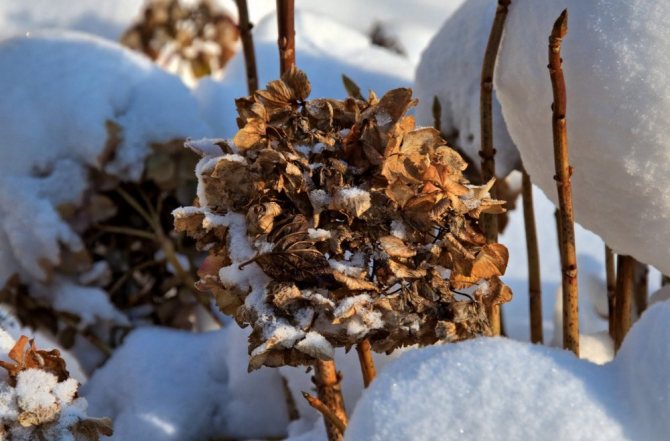

Panicle hydrangea is often grown in the regions of the Urals and Siberia due to its good frost resistance. In order for the plant to overwinter well, you need to protect the root from freezing by mulching the trunk circle.
Shelter of large-leaved hydrangea is carried out gradually
- You need to start by mulching the base of the shrub. Peat, pine litter or even fallen oak leaves are perfect for this, because they do not rot.
- Also, be sure to remove both drying and green foliage from the shoots, as under cover it can begin to rot and harm the shrub.
- If the bush is young, do not tie the shoots tightly together, and if the hydrangea is already quite thick, then combine the branches in 4-5 pieces to tie them. It is not recommended to use synthetics and it is better to tie it with some kind of soft material so as not to damage the shoots.
- The bundled bundles are bent to the ground very carefully, slowly, to avoid the possibility of damage.
- When the associated shoots are already at ground level, fix the bundles. For example, metal staples are suitable for this.
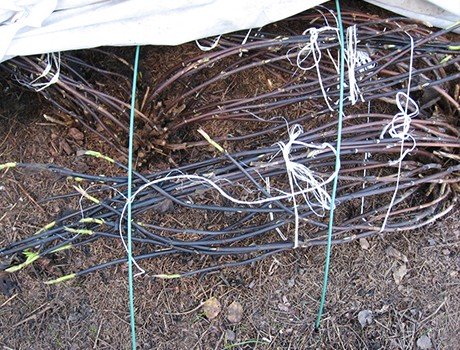

- While night temperatures are above zero, wrap the resulting structure with covering material.
- When the cold comes, sprinkle peat or dry leaves on top of the covering material. Moreover, attention should be paid to the shoots from the middle to the ends, because we have already slightly spud the lignified bases and this will be enough for them.
- Finally, you should install arcs or any other frame and cover it with a covering material.
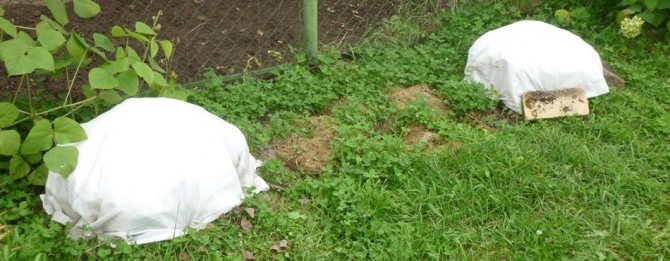

Under such a warm "blanket" your large-leaved hydrangea will perfectly live until spring, even if the winter is frosty enough, but not very snowy.
Features of planting hydrangeas in the Siberian climate
For cultivation in Siberia, it is necessary to purchase seedlings of varieties zoned for local climatic conditions, grown in the same Siberian nurseries. Plants over 3-4 years old take root best. A thermophilic tender hydrangea is planted only after the threat of returnable spring frosts has blown, that is, at the end of May or at the beginning of June.
It is advisable to buy planting material just before planting. If this is not possible, then you need to make sure that the earthen ball and, accordingly, the root system are always moist.
This decorative shrub feels more comfortable and blooms more abundantly in a place protected from strong gusty winds (near a fence, a house wall, etc.), in bright, slightly diffused lighting... It is best if the plant is illuminated by sunlight in the morning, and in the afternoon it is in partial shade, for example, large trees or shrubs. The soil should have a weak or medium acidity, alkaline soil for hydrangeas is destructive.
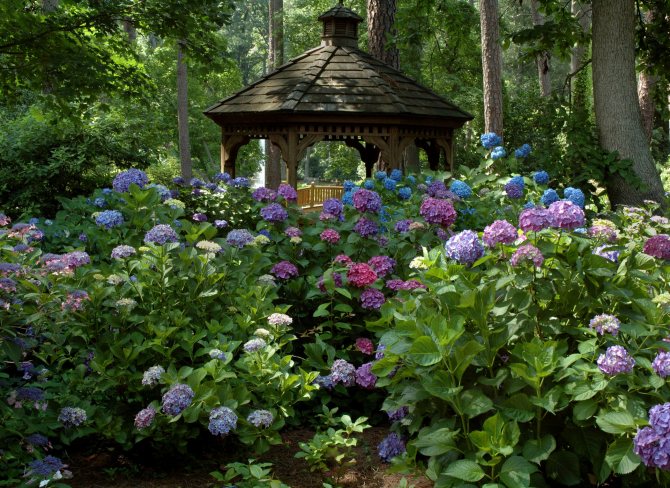

Hydrangeas thrive best in light partial shade, but they can grow in the sun.
Soil preparation
It is extremely important to properly fill the planting pit, the survival rate of the seedling greatly depends on this.... Its size is determined by the dimensions of the planted bush:
- 50 * 50 cm - for the little one;
- 80 * 80 cm - for large.
If you plan to place several specimens, then leave at least 2–2.5 m between them. The depth of the pit varies from 40 to 60 cm, depending on the size of the root system. A few hours before planting, the pit is filled with water (2-3 buckets), which should be completely absorbed. Then a special soil mixture is prepared from:
- fertile garden land - 2 parts;
- humus or well-rotted compost - 1 part;
- low-lying peat - 2 parts;
- coarse clean sand - 1 part.
Fertilizers are additionally applied:
- urea - 20-25 g;
- superphosphate - 50-60 g;
- potassium sulfate - 25-30 g
To acidify the earthen mixture, it is recommended to add pine or spruce needles to it.
All components are thoroughly mixed, the resulting soil is filled about half of the planting pit.
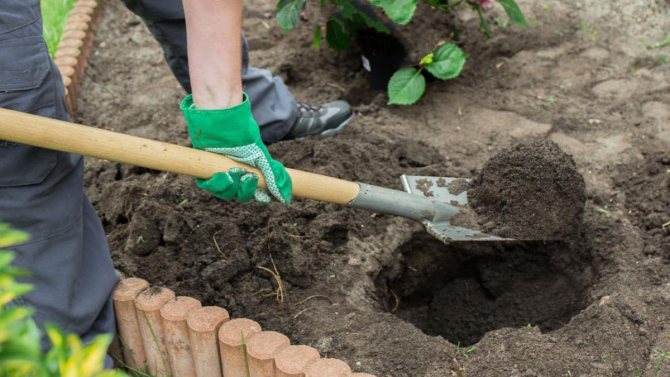

The planting hole for the hydrangea is filled with a special soil mixture
Instructions for planting a plant in open ground
Before planting, it is recommended to slightly shorten too long roots of the seedling (if it is not with a closed root system) and prune the shoots (up to 5-6 buds). Then proceed as follows:
- The seedling is placed in the center of the planting pit, the roots are carefully straightened.
- The root collar should be flush with the soil.
- Holding the stem, the hole is filled to the top with the remaining soil mixture.
- Compaction of the earth.
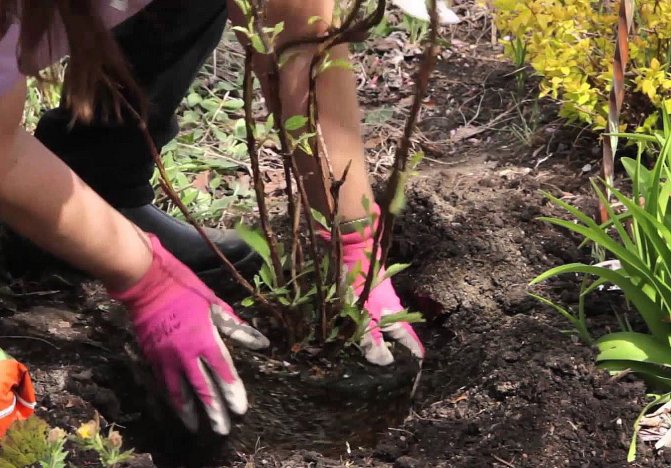

The earth is well compacted with hands
- It is well watered with settled lukewarm water (not cold tap water or well water).
- Mulch with peat, pine needles, sawdust, etc.
Preliminary activities
Before covering the hydrangea, it is necessary to trim the leaves. After that, the branches need to be collected in bunches and tied. This is necessary so that the shoots do not break from bending. Further, the associated shoots must be tilted and pressed against the soil, and then fixed with metal clamps. Curved welding electrodes can be used instead. If the shoot is lignified and resists bending, then the procedure is carried out gradually.
Did you know? Hydrangea absorbs aluminum from the soil, which is why some species are able to acquire a bluish tint of flowers.
Pruning
Timely pruning of the plant is necessary in order to ensure full flowering in the future.... It is performed before the onset of frost. September is considered the most suitable time for Siberia. Having cut off the buds and leaves that have dried up in autumn, you can not worry that they will rot under the winter shelter. During the procedure, you should leave the flower buds, which cover the special leaves.
When pruning a plant, you need to adhere to the following rules:
- remove branches only from healthy specimens, which at the time of the care procedure are already 4 years old, in order to avoid decay;
- from old shrubs, branches can be removed almost completely in order to get new young shoots in their place;
- rejuvenation is carried out no more than once every 3-4 years.
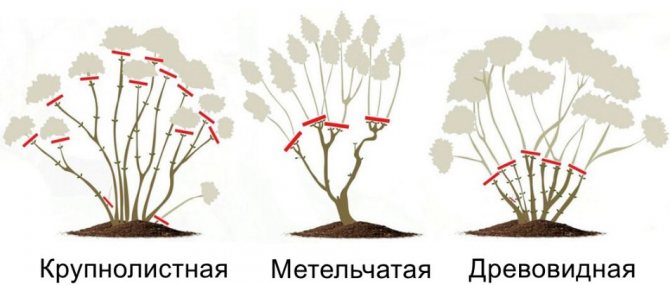

Top dressing
Top dressing is done twice a year. PThe first time fertilization is applied in the spring, the second - during the appearance of inflorescences. For spring fertilization, a mixture of potassium, superphosphate and urea in equal proportions is best suited. One shrub should have about 120 g of fertilizer. During the flowering period, feeding is carried out using superphosphate and potassium in a 2: 1 ratio.


Prevention of pests and diseases
A prerequisite for preparing hydrangea for wintering is its preventive treatment against pests and diseases. For this purpose, the shrubs and the soil around it are sprayed with 3% Bordeaux liquid or 1% copper sulfate solution. The procedure is carried out in autumn at a temperature of about + 7 ° C, when the leaves have already fallen off. This will help protect the shoots from pests and diseases that can attack the plant when it gets warm.


Features of wintering of different varieties


Hydrangea is a shrub with a height of one to three meters. Varieties are divided into evergreen and deciduous. In a cold climatic zone, it is possible to grow only deciduous hydrangeas.
How wintering is organized depends on which variety is growing in your garden.
— Arboreal, paniculate - tolerate frost well and recover quickly in spring.
— Large-leaved - not resistant to frost. It blooms on last year's shoots, which freeze in winter. Therefore, this variety may never bloom in open field conditions.
— Himalayan (ground cover) - the most winter-hardy species, requiring minimal shelter for the winter.
— Dubolistnaya - low winter resistance, it is recommended to plant in those places of the garden that are most protected from the winds. For the winter requires careful shelter.
— Pereshkovaya - hardy, does not need shelter for the frost period.
Hydrangea in autumn - preparing for winter
How to prepare hydrangea for the winter? - Preparation for wintering this adorable flower consists of two stages... The first of these is leaving in the autumn, on the eve of the onset of the cold winter period.


The preparatory period begins in September... At this time, watering of the plant is sharply reduced, gradually stopping it altogether.
If it rains heavily in autumn, then it is better shelter plant so that excess moisture does not get on it. For this, you can put a wire frame over the bush, which is covered with a film during the rain. The shelter must be made in such a way that moisture does not enter the root system. The less water the roots receive, the more successful wintering will be.
In order for new shoots formed in the current vegetative period to mature and become lignified, it is carried out feeding hydrangeas. Fertilizer should be composed of phosphorus and potassium.
With the onset of cold weather, the hydrangea will begin to actively shed its foliage. With the onset of a severe cold snap, it is advisable to help her get free from the remaining foliage.


The upper part of the stems is cut in autumn, also remove all inflorescences... After dropping all the foliage and pruning the shoots, they should be tied. A mulching layer is poured under the bush, it should wrap the base of the bush, cover the entire root system.
How to cover a hydrangea for winter?
The purpose of the winter shelter hydrangeas - keeping buds on young shoots. Winter care is necessary for hydrangea, and this is important because it is they who provide flowering (you can learn more about how to care for garden hydrangea here). And what is the point of growing a bush on which flowers do not form?
Without additional shelter, only petiole hydrangea.
Tree hydrangea takes refuge in the first year after planting. An adult specimen only needs to be spud, no additional shelter is required. But some newly bred large-flowered varieties are still better covered. This is due to the fact that their flowers are formed on the shoots of the last year, and if they freeze, the plant will not bloom.
For other varieties, it is required additional shelter... It is required to cover the hydrangea before the onset of frost, since delicate shoots do not tolerate frosts below minus 5.
A wooden box is placed next to the bush, shoots are laid on it and the entire structure is covered with spruce branches or covering material.
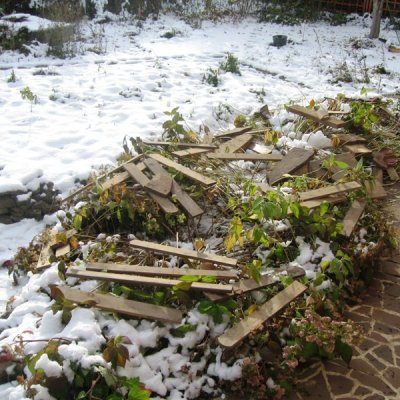

You can also cover the base with twigs, then bend the branches around to the ground and fix it. The center is covered with peat or sawdust, and spruce branches are laid on the branches. On top of the spruce branches, the bush is covered with a covering material, it is fixed on all sides. With a similar method of shelter, hydrangea can tolerate temperature to minus forty.
If the bushes are still small, you can completely cover them with earth, and spruce branches on top. Alternatively, you can install iron supports around their perimeter, and pull the mesh around.Dry foliage is poured inside the structure, and covered with a film on top.
Tall old bushes have poorly bending shoots, so the described methods for them unsuitable... They are tied up and wrapped in a covering material. A wire or U-shaped reinforcement is installed crosswise over the bush. The result is a kind of canopy, which is covered with a film.
If the bushes are planted in a group, you can make a common shelter for them. With this type of shelter, each bush is mulched. Then iron or wooden stakes are set around the group in a circle. The structure is wrapped in burlap or covering material. From above everything is covered with a layer of film or roofing material.


